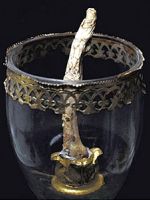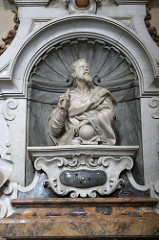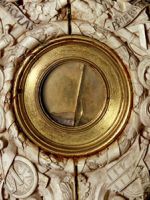BBC: Joan of Arc remains 'are fakes'
Bones thought to be the holy remains of 15th Century French heroine Joan of Arc were in fact made from an Egyptian mummy and a cat, research has revealed.
Another victory for science over religious dogma, we might think, but we shouldn't smirk: remember Piltdown Man? OK, I know the debunking of Piltdown Man was also a victory for science, which is supposed to continually challenge its own theories and data, but egg was definitely left on certain faces.
I don't get it with bodily relics, I really don't. Fascinated though I am by Charles Darwin, if someone were to offer me a peek at his skull buried beneath the flagstones of Westminster Abbey (assuming it hasn't crumbled to dust by now), I would politely decline. Let the poor man rest in peace! And as for Einstein's brain, sliced, diced and pickled in assorted jars, no thank you very much. It's damn morbid.

IMSS, Florence.
While there's an outside possibility that an analysis of Darwin's remains might give us some clue as to the mysterious illness that plagued his life following the Beagle voyage, and Einstein's brain has supposedly been used for scientific research into the nature of genius, I simply don't get the (usually, but not exclusively, religious) fascination with preserving and worshipping bodily fragments from the great and the good.
Last month, I visited Florence, Italy, where I encountered a genuine, scientific 'holy' relic. In a glass case in the frankly wonderful Museum of the History of Science, I gazed upon the middle finger of the right hand of Galileo Galilei. The finger the great scientist raised metaphorically at his former ally Pope Urban VIII while rather patronisingly pointing out the weaknesses of the church's geocentric view of the universe.

Santa Croce.
(cc) Richard Carter.
There is, of course, quite a story behind how Galileo's finger came to be preserved in a museum in Florence:
When the heretic Galileo died in 1642, the Roman Catholic church could not bring itself to let his remains be buried in consecrated ground. Ninety-five years later, however, the church relented, and his remains were exhumed, relocated to the church of Santa Croce in Florence, and placed inside an impressive marble memorial, directly opposite a similar memorial to Michelangelo (another local who had his fair share of run-ins with the pope).
During the exhumation of Galileo's remains, on 12th March, 1737, the antiquary Anton Francesco Gori removed the middle finger of Galileo's right hand. The finger was later placed it inside a glass cup and set upon an alabaster plinth bearing a verse by Tommaso Perelli, which translates from the original Latin as follows:
This is the finger, belonging to the illustrious hand
That ran through the skies,
Pointing at the immense spaces, and singling out new stars,
Offering to the senses a marvellous apparatus
Of crafted glass,
And with wise daring they could
Reach where neither Enceladus nor Tiphaeus ever reached.
That's antiquaries for you, I guess.

IMSS, Florence.
But sitting right next to Galileo's finger in the museum display case was a proper scientific relic—an artefact far more important and moving than a few desiccated carpal bones: the actual piece of crafted glass referred to in Perelli's poem; the original objective lens from the telescope Galileo used to discover the first four satellites of Jupiter, thereby proving beyond doubt to any reasonable person that not all heavenly bodies orbit the Earth.
The sights Galileo saw through that small piece of glass shook the world.
And then, in the next room, there they were: a couple of Galileo's original telescopes. Holy crap!
Galileo's lenses and telescopes are surely the right kinds of scientific relics to gawp at in awe; not some pseudo-religious bone fragments.
See also some of my holiday snaps: